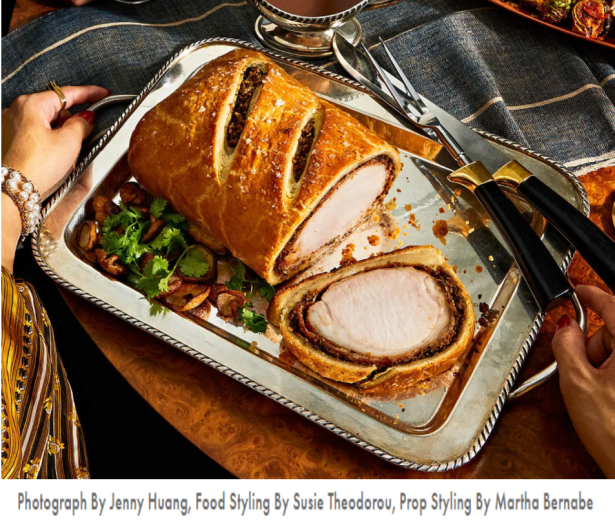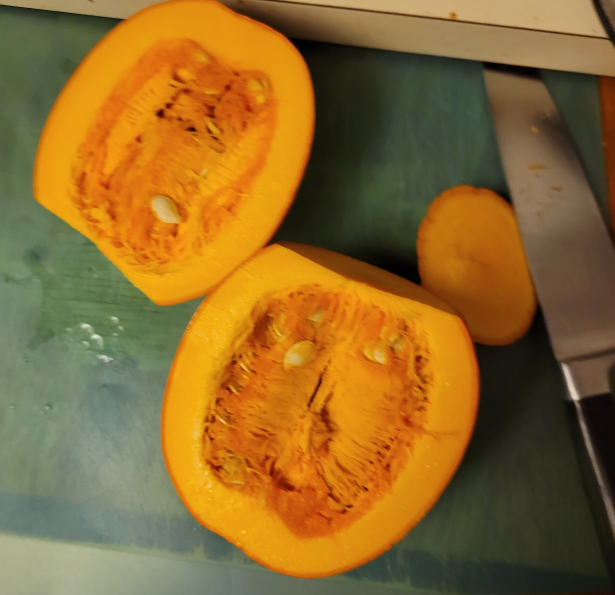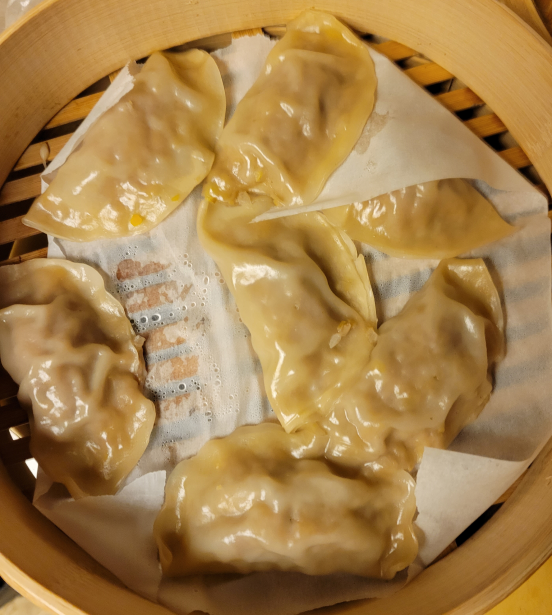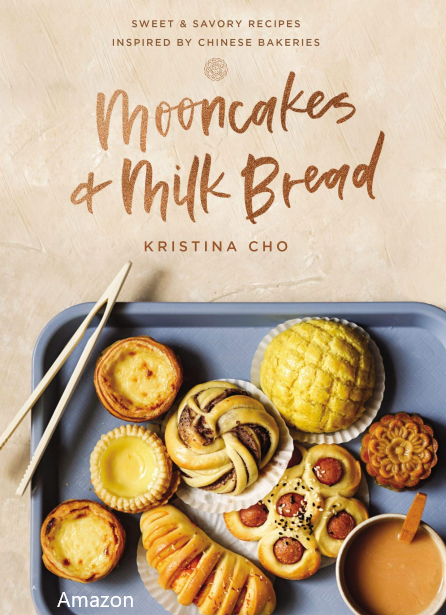KC 295 – The Many Problems with "Pumplings"

Why hello there, and welcome to Kitchen Catastrophe, where we’re really making a mess of things today, folks. A pretty bad name, a fairly bad time… but is it bad food? We’ll see. Anyway, if you want to go in blind, and no nothing of what awaits you, click this link. (Editor’s note: Actually, sorry, no. You dont’ get a link, because I cam’t make the Code block tab do what it’s done for well over a year. I guess literally EVERY part of this process wanted to be unnecessarily difficult.) For everyone else, let’s dig in.
A Cursed Beginning
So, to explain, today’s post is one bred of an airy word. A couple weeks ago, I had resolved to set down a plan for the next two month’s posts, with the idea being, as it has often been over the last few years, that I could front-load recipes for December, when I go work in Leavenworth, so that I don’t have to fit planning and cooking into a schedule that now includes an actual job for 5 days a week.
Crucial work, as seen here by my mid-day quilt of bracelets.
As such, I engaged in one of my classic “teeth pulling” exercises, of suggesting recipes to Nate and my mother, also called “endlessly assailing an armory of apathy”. However, this time, I had a secret weapon: PANDERING. Specifically, as the weather was getting colder, I know that a fair number of my family’s ‘traditional’ recipes are tailor-made for this season: a lot of my family’s ‘classic’ dishes are things like casseroles, chili, big batches of tacos, etc. And it was a topic I wanted to explore because, to be…emotionally transparent, I suppose, I’ve recently been struggling a little. I’ve felt that, while I do deeply enjoy expounding on cool histories and details of dishes, there’s some frustration in being, essentially, a culinary adaptor, in the technical, CABLE sense of the word. It’s been a long time since we made something really PERSONAL, rather than “here’s a cool dish I learned about”. So I wanted to try bringing in more O’Guin recipes. More stuff that we can connect with, and explore the history of.
Anywho, this produced some solid results, in that I was actively getting suggestions of stuff to make from them for the first time in quite a while. And then…something happened.
The specifics are unclear: I had sketched out a rough plan for the rest of the year, and was discussing it with them. And I was highlighting that I felt a couple of the options were weaker than others, or poorly timed, and giving options/examples of stuff we could do otherwise. And SOMEHOW, “Pumpkin dumpling” came up. We straight up don’t remember how. There is a recipe for Sweet Potato Jiaozi (the Chinese form of Gyoza) in one of the cookbooks we had with us, we were looking at a magazine with a bunch of Asian-Fusion recipes (like Char Siu Wellingon: Char Siu being the formal name for “Barbecue Pork” you get as an appetizer at Chinese restaurants, and Wellington referring to “A roast of meat encased in mushrooms and puff-pastry”, most commonly used for Beef Wellington.)
Which means that a wellington is, therefore, technically, a roasted dumpling.
It might have just been a slip of the tongue: someone stuttering and saying “pumpling” instead of “dumpling”. But however it happened, my mother got what some may identify as the “Oh-No O’Guin” Look. The look that says “I’ve had an awful idea. A wonderful, awful idea”. She was VERY taken with the idea of a “Pumpling” (though she has noted, in retrospective interviews, that she mentally constructed it as more of a Italian-Chinese fusion than what we eventually went with: she envisioned pumpkin, walnuts, brown butter, maybe some sausage: something closer to a Chinese dumpling form of butternut squash ravioli than what we ended up with.) And maybe we’ll make that at some point. (hell, we might make it VERY SOON, as you’ll learn in a bit) But for the initial run-up, I was more focused on what OTHER people had done with “pumpkin dumplings”, and found a couple interesting options. One recipe in particular stood out, as it was a “Sweet and Spicy Pumpkin and Turkey Dumpling”, made using Honey and Gochujang, and the creator colored the dough so that her dumplings were orange balls with green tops.
Which is a very cute idea, and also more than I had the energy for (Editor’s Note: that statement gets REALLY FUNNY in a bit.) so I instead decided to go for something fairly simple, and also somewhat timely: A recipe for Manti. Manti are…complicated, and also not complicated. You might remember that, while discussing Pelmeni, we briefly touched on the fact that between Central Asia and East Asia, we have a lot of clear cross pollination. China has jiaozi, Japan has gyoza and apparently Azerbaijan has gürzə, which they SWEAR is named for completely different reasons. Similarly, China has Mantou, Korea has Mandu, and this guy in Central Asia. Hell, if you go onto the Wikipedia page for Mongolia buuz dumplings, it specifically recommends you check out mandu, momo, pelmeni, Vareniki, gyoza, and more, as variations of the same dish.
Real buuz-hounds, those Mongolians.
That pun works much better in text, since listening to Mongolians say the word, it sounds closer to “buhz” or “bohz” than “booz”
So, basically, we’re making Uzbek gyoza…kinda. See, the one connection many suggest as the connecting point is the Uighurs. The history here is…INSANELY complicated, but basically, thousands of years ago, some people moved out of China into what’s now Mongolia. Some of those people then became the origin of ‘the Turks”, but they didn’t all go to what is now Turkey. The Uighurs are a Turkic ethnic minority, predominantly found in northwest China, who are like…Muslim-Mongol-Russian Chinese who live in a desert the size of Texas north of Tibet. Super interesting group, lot of weird details about them culturally and historically, and they have been in…what could be described as a lukewarm war with the rest of China for like, 30-50 years, with some violent riot or terror attack occurring once or twice a decade, culminating in 3 attacks over the course of 3 weeks in 2014, which generated a real pushback by the CCP. And by “real pushback”, I mean “There is a roughly even split in the United Nations over whether what is being done is legally genocide”. And…I mean, if it’s NOT, then we probably need a new word for the specific kind of fucked-up this is. I mean, this looks like they said “let’s try doing a worse version of how the US ‘re-educated’ Native Americans and see how that goes”. At least we never put ELECTRIC FENCES around the schools we forced their children to go to after we tore them from their homes. (Likely because we had yet to invent the electric fence before those fell out of style, but small victories.) So this is kind of “what the Central Asians say the Uighurs do”. Got it? Can I move on from this huge bummer to how things got complicated? Great.
A Chip, A Chop, A Flip and a Flop
So, like I said: I was not in a mental place to make this 100% authentically. My mom wanted “pumplings”, so I was just kitbashing a pumpkin-stuffed dumpling recipe based vaguely off of this one from Peter’s Food Adventures. And I said to myself: do I care about getting this dough correct? And I said “this is a knock-off of a knock-off, and physically making the dough takes, according to this recipe, 90 minutes. Fuck that, I’ll use pre-made gyoza dough, and have this done in like, 40 minutes total.” So we started by cutting open some pumpkins
The bottom one’s guts looks like what would happen if a child had to draw a picture of me.
Now, if YOU want to make your life even easier, you can cheat, and skip a step of mise-en-place. Specifically, the recipe calls for “pumpkin pieces”, so you can either do what we did, and peel, clean, and chop up pumpkin for 20 minutes, or you can just buy pre-chopped butternut squash. Is it ‘pumpkin’? No, but squashes are also native to North America, so this is clearly an adaptive process, and butternut and pumpkin are typically interchangeable in savory dishes.
Now, the core of this recipe is relatively simple and straight forward: you can chop the pumpkin, and some onions, into tiny bite-sized pieces yourself, or you can chop them up in a food processer. Once processed, you add the processed veggies to some mixed up beef and lamb meat, along with some very basic ingredients: just salt, pepper, water, and oil. And, to be honest, kind of insanely LITTLE of them. Like, this is over 4 pounds of mixture, and you’re adding 1 tablepoon of salt. That’s very little. Like, “1 gram of salt per ounce”. And HALF that of pepper. But it’s what the recipe said. So we put it together. Into each wrapper goes about 1 tbsp of filling, and fold it up, and we steamed some.
We have not mastered the technique of not having our dumplings look pathetic when steamed.
Now, at this point, the perceptive or critical thinkers among you may have just flinched in something akin to horror. Let the others catch up, because while we started working on the second batch of dumplings, my mother and I actually remembered a trick from our new dumpling cookbook. (Technically, and stating this will reveal how deeply my family’s hoarding instinct goes, but I’m referencing the cookbook used in our Crab Rangoon post…which I don’t think is even in the 3 newest “books with dumplings”) Specifically, we remembered that you can check for seasoning on dumpling seasoning by microwaving a teaspoon of filling for 20-30 seconds. Trying it, we determined that the original recipe was…let’s call it “too subtle” for our tastebuds, and we doubled the salt and pepper in the recipe, AND added in about 1 tsp of Trader Joe’s Everyday Seasoning, which adds in some chili pepper, coriander, and other complex flavors.
I have just realized that I’ve started the last three paragraphs with “now”, so I’m clearly fading as I write this, but that’s actually appropriate, because we can discuss/reveal the thing we just brought up that some of our readers have spotted. See, fun fact: one tablespoon is about half an ounce. Meaning it takes 2 dumplings to use up one ounce of filling. Out of a 4 pound mixture. That’s 128 dumplings. That was WAY too many for us to make the way we tried to start this recipe, so what we did was churn out around 28-30 of our “basic” batch, call it a night, and then, on Monday, we spent around 3 hours making 4 additional variations , to use up the rest of the filling. So I’m going to tap out writing this for the evening, and let Tuesday morning Jon wrap all this up.
The Follow-Up
Why hello there! Tuesday EVENING Jon here, to wrap this up, because Jon woke up with a migraine, took his medication, and passed out for 4 hours. SO LET’S GET THIS BAD BOY OUT THE DOOR.
Monday Afternoon consisted of 3+ hours of making around 100 dumplings, which we decided to construct into 4 flavor profiles. We already had the original 30 in what we’ll call “OG” Style, since it’s the original version with a small amount of added spice.
Off of that base, the first variant we created was “Fall Fruit”: we wanted to try and experiment with a variety of savory and sweet dumplings, so for the first one, we mixed in 2 tbsps of honey, 2 tbsps of chopped dried fruit, and 1 tsp pumpkin spice. How did it turn out? Good question, but wait for the end.
Batch #3: On Monday afternoon, while writing this post, I realized that the blog that had the “sweet and spicy” dumplings mentioned earlier is a blog titled “Eat Cho Food”, written by Kristina Cho. Which is relevant, because last week, my mother bought Mooncakes and Milk Bread, Cho’s new cookbook.
A book I could not find to take a picture of, so here’s the picture of it on Amazon. I swear, sometimes it’s like the house is cursed to be mildly inconvenient.
Ashamed that we had missed an INCREDIBLY EASY tie-in, I insisted we try a rough approximation of her recipe, adding 2 tbsps honey, 2 tbsps gochujang, and 1 tsp minced garlic to the 14 oz ball of filling.
For the 4th batch, my mom had, somewhat uncharacteristically, made an impish suggestion while we were cleaning the counter to give ourselves workspace, as she’d found a bottle of Haute Sauce (a small-batch hot sauce company out of Portland OR whose products I’d picked up in Leavenworth) Ghost Chili Apple, figuring that apples and pumpkings pair well together, and that the heat of ghost pepper would be a “fun surprise”. Riffing on that same idea, I built it into what we’re calling “Chinese Barbecue”, by adding hoisin sauce to the mixture. So this is really just Hoisin and Hot Sauce.
Lastly, we discussed several possible options, from a Mediterranean one (playing off the Beef-Lamb meat mixture that you see in Kofte and Gyros), to a Pho based one (fortifying the beef flavor, adding in anise and herbs), which led to the one we decided to do: a “jjigae” flavored one, because by dicing up about 1/3rd cup of Kimchi, we could finish off a bottle and make room in our fridge. So we did Kimchi, Beef Bouillon powder, some Trader Joe’s Umami seasoning, Gochujang, and some smoky hot sauce (Our gochugaru was a little inconvenient to reach, so we used this as a substitute.
We froze most of them, but steamed up several. What’s the verdict?
Looks like a dumpling.
The pre-OG batch, as we noted, was rather…bland. In a way, it feels like it adds to the authenticity to have this supposed original recipe for these style of dumplings be the least flavorful version we’ve encountered. It suggests they were legitimately a food of necessity, and the other cultures all had a strong backbone to build on. The pumpkin isn’t fully softened*, so there’s a bit of texture to them, but they feel and taste like a fairly neutral version of the dish.
(* - I want to note that this may be unintentional: Peter’s recipe from his blog notes that you’re supposed to steam the manti for 30-40 minutes, “until the meat is ready”. Which I assumed was a typo, because straight-up, the meat will be fully cooked in 3-4 minutes. 30 minutes is like how long you steam RAW POTATOES or ‘pots full of tamales’. But some other recipes suggest a 20 minute steaming time, so maybe I’m missing some kind of barbecue-esque breakdown of the filling, and saturation of the dough. I intended to check this today, but the whole migraine thing means I’ll post-pone it till Wednesday and do a follow-up edit.)
Because they were so unremarkable, we created the “OG” batch, which is just “the original recipe, with more seasoning”, and that tasted…like a dumpling. It was an improvement, but not in any ground-breaking way.
Batch 2: the Fall Fruit. This one worked okay, other than the fact that 1 tsp of pumpkin spice was too much. These were one-note, cinnamon and nutmeg.
Batch 3: These were fine. I personally wouldn’t have been able to tell you they were gochujang and honey, but they were certainly a little more complex, with a faint spice, versus the others.
Batch 4: The meat mixture drank up a frankly frightening amount of both seasonings for this recipe: we ended up with 4 tbsps of hoisin, and 2 tsp of Ghost-Pepper hot sauce, and I still could only BARELY taste the ghost pepper, mostly getting a hint of anise from the hoisin.
Batch 5: This was the most distinct batch, which I think hints to us that liquid flavors don’t stand up well to steaming, as the added crunch and flavor of the diced kimchi are what made that true. I honestly felt this was ‘hotter’ than the ghost pepper, in terms of detectable spice.
Conclusion: This is honestly a pretty simple recipe, and one that’s obviously RIPE for experimentation and exploration. The downside is that it’s a COMMITMENT. You want to set aside an afternoon to make all the dumplings from this recipe. And again, you’ll making probably enough for 20 servings of 6 dumplings each, so it’s something you’d only need to do once or twice a year, so I do think it’s worth giving a shot. My mother openly suggested we’d be trying, if not this exact base again, something similar. So if you’ve got a day to churn out dumplings, I suggest you give it a shot yourself. After all, it almost CANNOT be more of a mess than this shambling horror that still turned out success!
THURSDAY: COOKBOOKS, PROBABLY.
MONDAY: MAN, I DO NOT KNOW. I HAD A PLAN, BUT WE GOTTA GET SUPPLIES FOR IT, AND THAT MIGHT BE TRICKY.
Recipe
Basic “Pumpling” Mix, OG style
Makes filling for roughly 130 dumplings
Ingredients
2 large onions, cut into chunks
1½ lbs /750g pumpkin pieces
1½ lbs /750g ground beef and lamb mixed (we went 2 to 1 beef vs lamb…not for a real reason, but because SOMEONE forgot to put one of the pounds of lamb in the fridge)
2 tablespoon salt
1 teaspoon black pepper
1 tsp Trader Joe’s Everyday Seasoning (if unavailable, use 1/8 tsp ground coriander, ¼ tsp red chili flakes, ¼ tsp garlic powder, and an extra ½ tsp black pepper.)
½ cup oil
¾ cup water
Preparation
In a food processor, pulse the onions for around 7 pulses, until in small pieces, but not paste. Empty into a large bowl. Pulse pumpkin pieces in two batches for around 12-14 pulses, until small. Dump in same bowl.
Combine remaining ingredients in the bowl, and mix until thoroughly combined.
Place into a gallon ziplock bag, and chill until portioning out.
Pumplings
Makes ~ 28 dumplings
Ingredients
1/5 recipe OG style Pumpling mix (roughly 14 oz)
½ cup water
28-30 gyoza wrappers
OPTIONAL FLAVOR VARIETIES
Fall Fruit – 2 Tbsp Honey, 2 tbsp Dried fruit, ½ tsp Pumpkin Spice
Sweet and Spicy – 2.5 Tbsp Gochujang, 2.5 Tbsp Honey, 2 cloves of minced garlic
“Chinese Barbecue” – 4 tbsp Hoisin sauce, 2 tsp Ghost-Pepper hot sauce
“Kimchi-jjigae” – 1/3 cup finely chopped spicy kimchi, 1 tsp beef bouillon powder, 1 tsp umami powder (or mushroom powder/more beef bouillon), 1 tbsp gochujang, 1 tsp smoky hot sauce.
Preparation
If using, mix optional flavor variety ingredient into Pumpling mix. Taste for seasoning by microwaving 1 tsp filling in a pyrex dish for 20-30 seconds. Adjust as desired.
When satisfied, begin making dumplings: place 1 tbsp filling per wrapper, and fold as directed. You can steam immediately for 3—4 minutes, or freeze on parchment paper, and steam for 6-8 minutes later.












